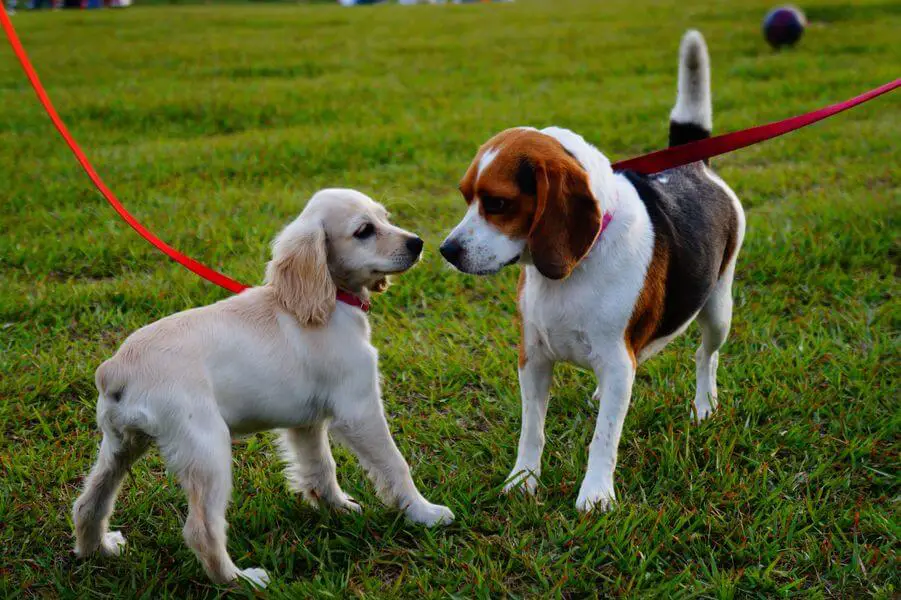Identifying the Cause and Treatment
It is always a good idea to have a general understanding of dog eye problems when you are the owner of a canine buddy. This knowledge can help you spot potential vision issues in the early stages so you can quickly get the veterinary help your dog needs. Understanding the differences between minor and severe canine eye problems can also help you differentiate between benign conditions and those that need urgent care.
Dog eye problems include such matters as Cataracts, Nuclear Slerosis, Corneal Ulcerations, Inflammation of the eyes, Conjunctivitis (Pink-eye), Inverted Eyelids, Eye Injuries, Simple Irritation of the eyes, and 3rd Lid Prolapse.
Cataracts Affecting Canines
This condition is determined mainly be genetics, although injury or accidents can also predispose a dog to cataract development.
With cataract formation the lens of the eye will become clouded. In some cases the whitening of the lens is so severe that it can lead to complete blindness.
Cataract surgery can be performed on dogs in a manner similar to the cataract surgeries that are performed on humans. The lens can be removed if the dog is having severe visual problems but the overall vision will never be the same as it was prior to surgery.
Nuclear Sclerosis
This dog eye problem is related to natural aging. The lens of the eye becomes filmy and blue in appearance. This is much different from the white or cloudy effects seen with cataract formation.
In the case of nuclear sclerosis a canine may have decreased vision or blurred vision but blindness will not result.
Canine Corneal Ulcerations
An eye that is swollen, a partially shut eye or clear, tear-like drainage from the eye can all be symptoms of corneal ulcerations. Even though some of these canine patients can have scary looking eyes as a result of this condition they should fully recover from this dog eye problem.
This type of eye problem often results from the eye being scratched. The scratching can be from a sticky thorn, sand and grit, a branch on a low hanging limb or a cat’s claw.
Most pets that suffer from these types of dog eye problems will only present with an eye that is half shut all the time or the animals will display copious amounts of tears from the affected eye. Do not try to remove any embedded object that you might see and get help for your four footed friend from a local vet.
Inflammation of the Eye(s)
Usually inflammation in the eye area is caused by some type of viral or bacterial infection. This condition can result from irritation to the eyes as well.
You can clean the drainage from around the affected eye(s) with a solution of 1 cup warm distilled water and 1/3 teaspoon of Epsom salt or pure sea salt. Let the salts dissolve in the warm water moisten a clean cloth and then use the cloth to clean around the eyes. You can even use gauze or Q-tips to do this type of cleaning.
If your dog appears to have dry eyes or moderately irritated eyes you can soothe the inflammation with a drop of castor oil or cod liver oil. For very minor irritation a drop or two of pure almond oil should suffice.
Conjunctivitis
If your dog has a bacterial eye infection it could result in conjunctivitis. This is when there is crusty drainage from the eye and the lids can stick together. The sclera will be very red and inflamed. A vet will give you an antibiotic ointment to take care of this type of problem.
Inversino of a Dog’s Eyelids
This is one of those dog eye problems that may result from genetic predisposition or chronically inflamed eyes. What happens is that the lids of a dog’s eyes will invert and the lashes are actually going to be rubbing against the corneal tissue. Severe ulcerations can result from this condition if it is left untreated for any length of time.
It is easy to look and see that your dog’s eyelids are in the proper position. If your dog should have inverted eyelids just use your fingers to correct the condition by pulling the eyelids back into their normal position. If your dog has ‘in-growing’ or permanently inverted eyelids the lids will immediately tuck backwards with the lashes against the corneal tissue.
You might want to try an ‘at home’ botanical remedy using goldenseal or silicea and see if these herbal formulas make a difference, especially if you have a very young dog. However your vet can correct this condition with a quick and safe surgical procedure.
Injuries to the Eyes of a Canine
There are a number of dog eye problems that can result from some form of trauma or injury. The eye of any dog can be scratched, bruised or penetrated by a foreign object or fight. Injuries to the eyes of a canine can also result just from his environment. Like any child most dogs are curiously inquisitive and their curious natures can lead them into dangerous situations that can damage their eyes or vision.
Many eye injuries will heal themselves and you may not even be aware of the damage that your dog has suffered. If you question your dog’s injuries it is always best to have your pet checked by a veterinarian.
For some blunt force eye trauma you may want to use comfrey to soothe and heal the dog’s eyes. There are some other herbal remedies that you can find to relieve the pain and discomfort, promote healing and ward off any infections.
Irritation to a Dog’s Eye
Sand, debris and pollen can all be irritants that cause dog eye problems. In some instances these irritants can even create slight scratches on the cornea of the eyes. When your dog has irritated eyes they will usually have clear drainage and sclera redness. Any canine that has swelling of the eyelids or partially closed eyes should be examined by your regular vet.
Rinse the eyes with a home based solution made from 1/3 teaspoon of Epsom salt or sea salt and a cup of warm, distilled water. You can even use diluted rosemary or chamomile tea to soothe and cleanse the dog’s irritated eyes. Repeat this eye rinse about 4-6 times a day until the eyes are back to normal.
Third Eyelid Prolapse in Canines
The clear membrane that protects the cornea of a cat or dog is known as their 3rd eyelid. The tear duct gland of canines is also part of the 3rd eyelid’s anatomical structure.
Irritation or extreme injury can make this eyelid become enlarged. When this situation happens you will notice that the 3rd lid becomes exposed and you can actually see it bulging against the eye. There is usually a yellowish exudate that is produced and this discharge will drain from the eye.
In some instances the prolapsed eyelid will return to normal with minimal treatment. Your vet may need to surgically intervene and remove the lid if severe problems should result. You can help alleviate any discomfort caused by this dog eye problem. Soothing, warm compresses and eye rinses are generally recommended as ‘at home’ treatment options.








